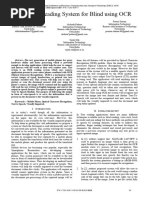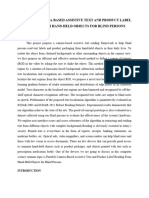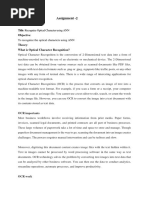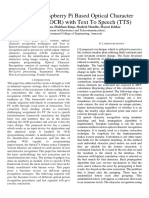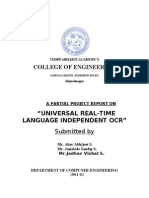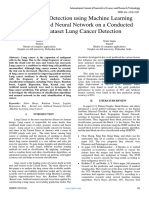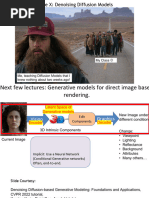Chapter 1
Uploaded by
Er Mukesh MistryChapter 1
Uploaded by
Er Mukesh MistryVACOE, AHMEDNAGAR Chapter 1
INTRODUCTION
1.1 PROBLEM DEFINITION & RELEVENT THEORY:Optical character recognition, usually abbreviated to OCR, is the mechanical or electronic translation of images of handwritten or typewritten text (usually captured by a scanner) into machine-editable text. OCR is a field of research in pattern recognition, artificial intelligence and machine vision. hough academic research in the field continues, the focus on OCR has shifted to implementation of proven techni!ues. Optical character recognition (using optical techni!ues such as mirrors and lenses) and digital character recognition (using scanners and computer algorithms) were originally considered separate fields. "ecause very few applications survive that use true optical techni!ues, the OCR term has now been broadened to include digital image processing as well. #arly systems re!uired training (the provision of $nown samples of each character) to read a specific font. %&ntelligent% systems with a high degree of recognition accuracy for most fonts are now common. 'ome systems are even capable of reproducing formatted output that closely approximates the original scanned page including images, columns and other non-textual components. (owever such techni!ues are limited to static scanned images, and not real time ac!uisi)ed handwritten characters. *ith advent of digital input devices li$e 'tylus, etc. the user can enter handwritten text as input to the OCR system. he system will have the capability of recogni)ing and updating the entered characters on-the-fly. his enables the user to rectify the errors at the time of entering the text and not when he+s done entering all the characters. he system will also host a universal language recognition capability. his can be achieved using pattern rec !n"t" n and #eat$re e%tract" n. ,attern recognition is a subtopic of machine learning. &t can be defined as %the act of ta$ing in raw data and ta$ing an action based on the category of the data%. -ost research in pattern recognition is about methods for supervised learning and unsupervised learning. ,attern recognition aims to classify data (patterns) based on either a priori $nowledge or on statistical information extracted from the patterns. he patterns to be classified are usually groups of measurements or observations, defining points in an appropriate multidimensional space.
Universal Real-Time Language Inde enden! OCR"
VACOE, AHMEDNAGAR
Feat$re E%tract" n &n pattern recognition and in image processing, /eature extraction is a special form of dimensionality reduction. *hen the input data to an algorithm is too large to be processed and it is suspected to be notoriously redundant (much data, but not much information) then the input data will be transformed into a reduced representation set of features (also named features vector). ransforming the input data into the set of features is called features extraction. &f the features extracted are carefully chosen it is expected that the features set will extract the relevant information from the input data in order to perform the desired tas$ using this reduced representation instead of the full si)e input. he system also employs some of the best image processing algorithms for the input to be suitable for feature extraction and pattern recognition. /ollowing are some of the image processing algorithms that will be used0 o o o o o 1rayscale Conversion hresholding #rosion 2 3ilation 'harpen 2 "lur &mage 'egmentation 4
Universal Real-Time Language Inde enden! OCR"
VACOE, AHMEDNAGAR
Universal Real-Time Language Inde enden! OCR"
VACOE, AHMEDNAGAR
1.& 'COPE:he proposed OCR system covers the range of topics, many shared with mainstream image processing. 'ome of the most important are0o 6nderstanding image user+s needs and information see$ing behavior. o &dentification of suitable ways of describing image content. o #fficient any number of feature extraction techni!ues. o ,roviding usable human interface to OCR within the vicinity of system.
1.( OB)ECTIVE:o o o o o o support more than one languages. o reduce total manpower re!uired for manual data entry wor$. o improve the !uality of the degraded data. o understand the different users handwritten scripts. o introduce the dynamic OCR system to the users.
Universal Real-Time Language Inde enden! OCR"
You might also like
- My Courses 2022 Second Summer CSC 7333 For Jianhua Chen Final Exam Final ExamNo ratings yetMy Courses 2022 Second Summer CSC 7333 For Jianhua Chen Final Exam Final Exam16 pages
- EEL6825-Character Recognition Algorithm Using Correlation.No ratings yetEEL6825-Character Recognition Algorithm Using Correlation.8 pages
- Optical Character Recognition (OCR) SystemNo ratings yetOptical Character Recognition (OCR) System5 pages
- Optical Character Recognition Project ReportNo ratings yetOptical Character Recognition Project Report71 pages
- Urdu Optical Character Recognition OCR Thesis Zaheer Ahmad Peshawar Its Soruce Code Is Available On MATLAB Site 21-01-09100% (1)Urdu Optical Character Recognition OCR Thesis Zaheer Ahmad Peshawar Its Soruce Code Is Available On MATLAB Site 21-01-0961 pages
- Build Your Own Optical Character Recognition (Ocr) System Using Google'S Tesseract and OpencvNo ratings yetBuild Your Own Optical Character Recognition (Ocr) System Using Google'S Tesseract and Opencv10 pages
- Optical Character Recognition Using MATLAB: Sandeep Tiwari, Shivangi Mishra, Priyank Bhatia, Praveen Km. YadavNo ratings yetOptical Character Recognition Using MATLAB: Sandeep Tiwari, Shivangi Mishra, Priyank Bhatia, Praveen Km. Yadav4 pages
- Cse Final Year Project Proposal PDF FreeNo ratings yetCse Final Year Project Proposal PDF Free10 pages
- Applying AI To Biometric Identification For Recognizing Text Using One-Hot Encoding and CNNNo ratings yetApplying AI To Biometric Identification For Recognizing Text Using One-Hot Encoding and CNN9 pages
- Plagiarism Checker X Originality Report: Similarity Found: 26%No ratings yetPlagiarism Checker X Originality Report: Similarity Found: 26%29 pages
- Analogic Preprocessing and Segmentation Algorithms For Off-Line Handwriting RecognitionNo ratings yetAnalogic Preprocessing and Segmentation Algorithms For Off-Line Handwriting Recognition20 pages
- Optical Character Recognition by Open Source OCR Tool Tesseract: A Case StudyNo ratings yetOptical Character Recognition by Open Source OCR Tool Tesseract: A Case Study8 pages
- Optical Character Recognition: Unlocking the Power of Computer Vision for Optical Character RecognitionFrom EverandOptical Character Recognition: Unlocking the Power of Computer Vision for Optical Character RecognitionNo ratings yet
- Optical Character Recognizer: Team MemberNo ratings yetOptical Character Recognizer: Team Member7 pages
- Multimedia and WS-CS 550-Content Analysis v1No ratings yetMultimedia and WS-CS 550-Content Analysis v127 pages
- Optical_character_recognition_system_using_artificNo ratings yetOptical_character_recognition_system_using_artific7 pages
- Optical_Character_Recognition_TechniquesNo ratings yetOptical_Character_Recognition_Techniques6 pages
- Practical Assignment 01: OCR - Optical Character RecognitionNo ratings yetPractical Assignment 01: OCR - Optical Character Recognition16 pages
- Optical Character Recognition (Ocr) : Karan Panjwani T.E - B, 68 Guided By: Prof. Shalini WankhadeNo ratings yetOptical Character Recognition (Ocr) : Karan Panjwani T.E - B, 68 Guided By: Prof. Shalini Wankhade24 pages
- Face Detection and Recognition Using Opencv and PythonNo ratings yetFace Detection and Recognition Using Opencv and Python3 pages
- Applying AI To Biometric Identification For Recognizing Text Using One-Hot Encoding and CNNNo ratings yetApplying AI To Biometric Identification For Recognizing Text Using One-Hot Encoding and CNN10 pages
- Vechicle number plate detection using python and cv pptNo ratings yetVechicle number plate detection using python and cv ppt13 pages
- A Review of Handwritten Text Recognition Using Machine Learning and Deep Learning TechniquesNo ratings yetA Review of Handwritten Text Recognition Using Machine Learning and Deep Learning Techniques6 pages
- Biometric Identification For Recognizing Text Usingvarious AI AlgorithmNo ratings yetBiometric Identification For Recognizing Text Usingvarious AI Algorithm6 pages
- Optical Character Recognition by Open Source OCR Tool Tesseract A Case StudyNo ratings yetOptical Character Recognition by Open Source OCR Tool Tesseract A Case Study7 pages
- CNN Based Digital Alphanumeric Archaeolinguistics Apprehension For Ancient Script DetectionNo ratings yetCNN Based Digital Alphanumeric Archaeolinguistics Apprehension For Ancient Script Detection7 pages
- Portable Camera-Based Assistive Text and Product Label Reading From Hand-Held Objects For Blind PersonsNo ratings yetPortable Camera-Based Assistive Text and Product Label Reading From Hand-Held Objects For Blind Persons6 pages
- Design of An OCR System and Its Hardware ImplementationNo ratings yetDesign of An OCR System and Its Hardware Implementation18 pages
- Raspberry Pi Based Smart Reader For Visually Impaired People50% (2)Raspberry Pi Based Smart Reader For Visually Impaired People12 pages
- Review Paper On Raspberry Pi Based Ocr With Tts (19104013, 18004037, 18004051)No ratings yetReview Paper On Raspberry Pi Based Ocr With Tts (19104013, 18004037, 18004051)5 pages
- Ijcet: International Journal of Computer Engineering & Technology (Ijcet)No ratings yetIjcet: International Journal of Computer Engineering & Technology (Ijcet)14 pages
- Text Detection in Natural Scene Images Using Ocr AlgorithmNo ratings yetText Detection in Natural Scene Images Using Ocr Algorithm3 pages
- Development of Text Extraction Technique 3acb33e9No ratings yetDevelopment of Text Extraction Technique 3acb33e98 pages
- Certificate Acknowledgement List of Figures List of Tables Abbreviation 1No ratings yetCertificate Acknowledgement List of Figures List of Tables Abbreviation 13 pages
- Question "Unit - 1": Q1 - Identify The Architecture and Explain It ?No ratings yetQuestion "Unit - 1": Q1 - Identify The Architecture and Explain It ?3 pages
- List of Figures I List of Tables II 1 1-2No ratings yetList of Figures I List of Tables II 1 1-22 pages
- Analysis: 4.1 Project Scheduling and TrackingNo ratings yetAnalysis: 4.1 Project Scheduling and Tracking16 pages
- 1.1 Problem Definition & Relevent TheoryNo ratings yet1.1 Problem Definition & Relevent Theory31 pages
- Brain Intelligence: Go Beyond Artificial IntelligenceNo ratings yetBrain Intelligence: Go Beyond Artificial Intelligence8 pages
- Lung Cancer Detection Using Machine Learning Algorithms and Neural Network On A Conducted Survey Dataset Lung Cancer DetectionNo ratings yetLung Cancer Detection Using Machine Learning Algorithms and Neural Network On A Conducted Survey Dataset Lung Cancer Detection4 pages
- Technologies-11-00091_Implementation of Deep Learning Models on an SoC-FPGA Device for Real-Time Music Genre ClassificationNo ratings yetTechnologies-11-00091_Implementation of Deep Learning Models on an SoC-FPGA Device for Real-Time Music Genre Classification18 pages
- Web Traffic Time Series Forecasting: Kaggle Competition Review Bill Tubbs July 26, 2018No ratings yetWeb Traffic Time Series Forecasting: Kaggle Competition Review Bill Tubbs July 26, 201839 pages
- ANN & FUZZY Techniques (MEPS303B) : Q1. Short Questions (Attempt Any 5)No ratings yetANN & FUZZY Techniques (MEPS303B) : Q1. Short Questions (Attempt Any 5)5 pages
- Neural Networks and Its Applications: Nishant Dr. Sumeet Gill Hemant PawarNo ratings yetNeural Networks and Its Applications: Nishant Dr. Sumeet Gill Hemant Pawar7 pages
- Datasheet - Artificial Intelligence EngineerNo ratings yetDatasheet - Artificial Intelligence Engineer2 pages
- LLM Training - A simple visual guide beginnersNo ratings yetLLM Training - A simple visual guide beginners10 pages
- Practical Natural Language Processing: A Comprehensive Guide To Building Real-World NLP SystemsNo ratings yetPractical Natural Language Processing: A Comprehensive Guide To Building Real-World NLP Systems8 pages
- Lecture7 8 - Diffusion - Model 1 78 1 66No ratings yetLecture7 8 - Diffusion - Model 1 78 1 6666 pages
- Will Human Beings Be Superseded by Generative Pre-Trained Transformer 3 (GPT-3) in Programming?No ratings yetWill Human Beings Be Superseded by Generative Pre-Trained Transformer 3 (GPT-3) in Programming?3 pages
- Lecture 13 - Supervised Learning - Bidirectional Associative Memory (BAM)No ratings yetLecture 13 - Supervised Learning - Bidirectional Associative Memory (BAM)4 pages
- 2023 07 28 Evolution of Language ModelsNo ratings yet2023 07 28 Evolution of Language Models73 pages
- AI Strategy Flow Chart Share by WorldLine TechnologyNo ratings yetAI Strategy Flow Chart Share by WorldLine Technology1 page
- My Courses 2022 Second Summer CSC 7333 For Jianhua Chen Final Exam Final ExamMy Courses 2022 Second Summer CSC 7333 For Jianhua Chen Final Exam Final Exam
- EEL6825-Character Recognition Algorithm Using Correlation.EEL6825-Character Recognition Algorithm Using Correlation.
- Urdu Optical Character Recognition OCR Thesis Zaheer Ahmad Peshawar Its Soruce Code Is Available On MATLAB Site 21-01-09Urdu Optical Character Recognition OCR Thesis Zaheer Ahmad Peshawar Its Soruce Code Is Available On MATLAB Site 21-01-09
- Build Your Own Optical Character Recognition (Ocr) System Using Google'S Tesseract and OpencvBuild Your Own Optical Character Recognition (Ocr) System Using Google'S Tesseract and Opencv
- Optical Character Recognition Using MATLAB: Sandeep Tiwari, Shivangi Mishra, Priyank Bhatia, Praveen Km. YadavOptical Character Recognition Using MATLAB: Sandeep Tiwari, Shivangi Mishra, Priyank Bhatia, Praveen Km. Yadav
- Applying AI To Biometric Identification For Recognizing Text Using One-Hot Encoding and CNNApplying AI To Biometric Identification For Recognizing Text Using One-Hot Encoding and CNN
- Plagiarism Checker X Originality Report: Similarity Found: 26%Plagiarism Checker X Originality Report: Similarity Found: 26%
- Analogic Preprocessing and Segmentation Algorithms For Off-Line Handwriting RecognitionAnalogic Preprocessing and Segmentation Algorithms For Off-Line Handwriting Recognition
- Optical Character Recognition by Open Source OCR Tool Tesseract: A Case StudyOptical Character Recognition by Open Source OCR Tool Tesseract: A Case Study
- Optical Character Recognition: Unlocking the Power of Computer Vision for Optical Character RecognitionFrom EverandOptical Character Recognition: Unlocking the Power of Computer Vision for Optical Character Recognition
- Optical_character_recognition_system_using_artificOptical_character_recognition_system_using_artific
- Optical Character Recognition: Fundamentals and ApplicationsFrom EverandOptical Character Recognition: Fundamentals and Applications
- Practical Assignment 01: OCR - Optical Character RecognitionPractical Assignment 01: OCR - Optical Character Recognition
- Optical Character Recognition (Ocr) : Karan Panjwani T.E - B, 68 Guided By: Prof. Shalini WankhadeOptical Character Recognition (Ocr) : Karan Panjwani T.E - B, 68 Guided By: Prof. Shalini Wankhade
- Face Detection and Recognition Using Opencv and PythonFace Detection and Recognition Using Opencv and Python
- Applying AI To Biometric Identification For Recognizing Text Using One-Hot Encoding and CNNApplying AI To Biometric Identification For Recognizing Text Using One-Hot Encoding and CNN
- Vechicle number plate detection using python and cv pptVechicle number plate detection using python and cv ppt
- A Review of Handwritten Text Recognition Using Machine Learning and Deep Learning TechniquesA Review of Handwritten Text Recognition Using Machine Learning and Deep Learning Techniques
- Biometric Identification For Recognizing Text Usingvarious AI AlgorithmBiometric Identification For Recognizing Text Usingvarious AI Algorithm
- Optical Character Recognition by Open Source OCR Tool Tesseract A Case StudyOptical Character Recognition by Open Source OCR Tool Tesseract A Case Study
- CNN Based Digital Alphanumeric Archaeolinguistics Apprehension For Ancient Script DetectionCNN Based Digital Alphanumeric Archaeolinguistics Apprehension For Ancient Script Detection
- Portable Camera-Based Assistive Text and Product Label Reading From Hand-Held Objects For Blind PersonsPortable Camera-Based Assistive Text and Product Label Reading From Hand-Held Objects For Blind Persons
- Design of An OCR System and Its Hardware ImplementationDesign of An OCR System and Its Hardware Implementation
- Raspberry Pi Based Smart Reader For Visually Impaired PeopleRaspberry Pi Based Smart Reader For Visually Impaired People
- Review Paper On Raspberry Pi Based Ocr With Tts (19104013, 18004037, 18004051)Review Paper On Raspberry Pi Based Ocr With Tts (19104013, 18004037, 18004051)
- Ijcet: International Journal of Computer Engineering & Technology (Ijcet)Ijcet: International Journal of Computer Engineering & Technology (Ijcet)
- Text Detection in Natural Scene Images Using Ocr AlgorithmText Detection in Natural Scene Images Using Ocr Algorithm
- Certificate Acknowledgement List of Figures List of Tables Abbreviation 1Certificate Acknowledgement List of Figures List of Tables Abbreviation 1
- Question "Unit - 1": Q1 - Identify The Architecture and Explain It ?Question "Unit - 1": Q1 - Identify The Architecture and Explain It ?
- Brain Intelligence: Go Beyond Artificial IntelligenceBrain Intelligence: Go Beyond Artificial Intelligence
- Lung Cancer Detection Using Machine Learning Algorithms and Neural Network On A Conducted Survey Dataset Lung Cancer DetectionLung Cancer Detection Using Machine Learning Algorithms and Neural Network On A Conducted Survey Dataset Lung Cancer Detection
- Technologies-11-00091_Implementation of Deep Learning Models on an SoC-FPGA Device for Real-Time Music Genre ClassificationTechnologies-11-00091_Implementation of Deep Learning Models on an SoC-FPGA Device for Real-Time Music Genre Classification
- Web Traffic Time Series Forecasting: Kaggle Competition Review Bill Tubbs July 26, 2018Web Traffic Time Series Forecasting: Kaggle Competition Review Bill Tubbs July 26, 2018
- ANN & FUZZY Techniques (MEPS303B) : Q1. Short Questions (Attempt Any 5)ANN & FUZZY Techniques (MEPS303B) : Q1. Short Questions (Attempt Any 5)
- Neural Networks and Its Applications: Nishant Dr. Sumeet Gill Hemant PawarNeural Networks and Its Applications: Nishant Dr. Sumeet Gill Hemant Pawar
- Practical Natural Language Processing: A Comprehensive Guide To Building Real-World NLP SystemsPractical Natural Language Processing: A Comprehensive Guide To Building Real-World NLP Systems
- Will Human Beings Be Superseded by Generative Pre-Trained Transformer 3 (GPT-3) in Programming?Will Human Beings Be Superseded by Generative Pre-Trained Transformer 3 (GPT-3) in Programming?
- Lecture 13 - Supervised Learning - Bidirectional Associative Memory (BAM)Lecture 13 - Supervised Learning - Bidirectional Associative Memory (BAM)
- AI Strategy Flow Chart Share by WorldLine TechnologyAI Strategy Flow Chart Share by WorldLine Technology





































